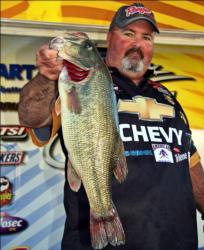How slow can you go?
Slow down with subtle falling lures
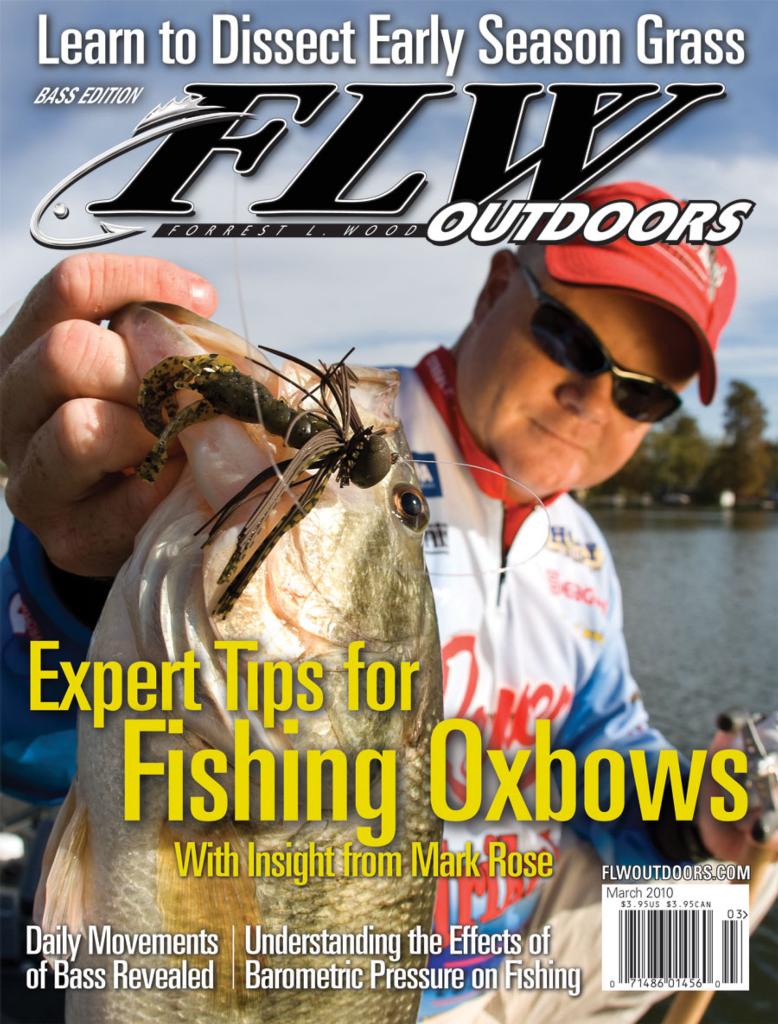
————————————–
Editor’s note: This is just one article from a recent issue of FLW Outdoors Magazine, which publishes both a Bass Edition and a Walleye Edition. To learn more about the magazine and how to subscribe, click here.
————————————–
Big bass inhaling fast-moving lures. That’s the norm for prespawn giants in east Texas. It has been for years and assuredly will be for years to come. So when the FLW Tour visited Lake Travis in February 2007, anglers no doubt had visions of egg-laden sows gorging on lipless crankbaits.
But that spring, the Travis bass didn’t respond. A brutal cold front had pummeled the hill country and turned those visions into nightmares.
The conditions left Chevy pro Dion Hibdon of Stover, Mo., struggling during practice. He had already scaled down to a diminutive 3/16-ounce jig to trigger strikes from lethargic bass, but the bites were still few and far between. Worse yet, most of his hooksets came up empty. Basically, it was looking like he was going to join the ranks of those who came to the ramp with empty livewells or pitiful one-fish bags.
“Every now and then one would knock slack in the line,” he said. “It would be whipping by and they’d whack it, but I missed them all.”
He had a lure they were inclined to hit, so he was hesitant to change his offering. However, some variation was necessary in order to preclude going home with his tail between his legs.
Hibdon pulled out a jig in the same color and style, with the same trailer, but in a 1/8-ounce version. A limit of nice bass followed shortly thereafter. He literally went from zero to almost hero in 1/16 ounce. Sometimes a slow fall can make a big difference.
Fast world in which we live
The marine and tackle industries have gradually moved to the point where speed is of the essence – 36-volt trolling motors, 250-hp outboards and 7:1 baitcasting reels are the norm these days. Even lead has become outdated, having been replaced with tungsten, which sports a smaller profile to fall faster than 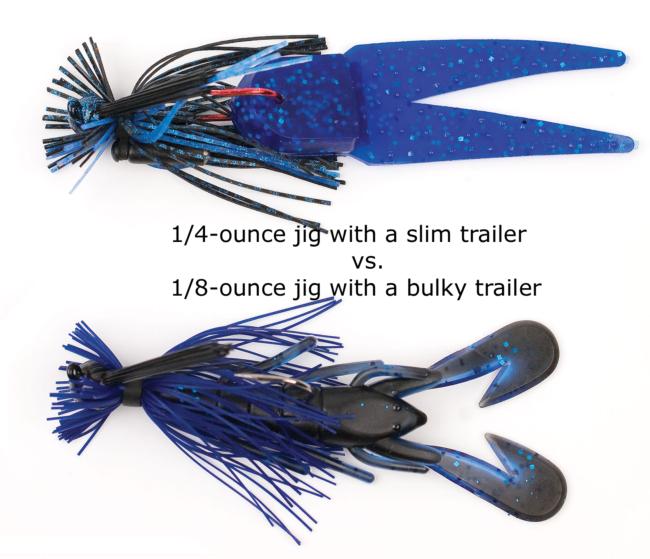 same-weight lead versions. But when weather slows down the metabolism of the prey, sometimes a delectably slow presentation is the only way to trigger a bite.
same-weight lead versions. But when weather slows down the metabolism of the prey, sometimes a delectably slow presentation is the only way to trigger a bite.
Think about it this way: You got up, ate breakfast and then shoveled snow all morning. Now you are sitting in the recliner in front of a fire watching football, half dead to the world. If someone shoves a giant meal in front of you, you might not be in the mood to eat. But if someone is cooking a homemade pie or a pot of soup and you are forced to sit there smelling the flavors, it might get your stomach growling. Smell it long enough, and when the meal is finally in your lap you are going to bite like there is no tomorrow.
The same holds true for bass in a neutral mood. A slow fall will sometimes tempt them when shoving lures in their faces won’t.
“It happens a lot around the prespawn,” Hibdon said, “and again late in the fall. Around here (in the Ozarks) that’s usually in the November time frame, after we’ve had a couple of real good cold snaps, maybe even some snow, and the water is down in the low 50s.”
Chevy pro Jay Yelas of Corvallis, Ore., agreed the prespawn is a popular time for slow-falling lures. However, he also includes other parts of the season as times to use the technique.
“It’s mostly around the spawn, when the fish are around beds, but also in the middle of winter, when the water is real cold,” he said.
In other words, fish that don’t have feeding on their minds sometimes need to be teased.
No rules, but slow can save the day
All three major species of bass – largemouths, smallmouths and spots – are susceptible to slow-falling temptations at times. But “at times” is the key. There are also times when it is an inappropriate and inefficient technique.
When punching lures through heavy vegetation or flipping thick brush, a light jig or unweighted soft plastic usually won’t get the job done because it can’t penetrate the cover. Plus, those techniques often rely on reaction bites.
Fishing in tinted water, extraordinary depths or current also demands a larger presentation that moves more water and gets into the strike zone faster.
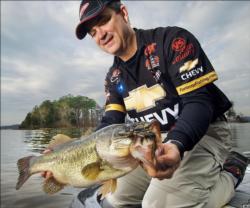 “The Tennessee River lakes and the Texas lakes like Toledo Bend and Sam Rayburn all are fertile bodies of water with some color to them,” Yelas said. “You don’t want to go light there. A 10-inch worm with at least a 3/8- or 1/2-ounce weight is the standard there. Finesse will actually get fewer bites because they simply can’t find it.”
“The Tennessee River lakes and the Texas lakes like Toledo Bend and Sam Rayburn all are fertile bodies of water with some color to them,” Yelas said. “You don’t want to go light there. A 10-inch worm with at least a 3/8- or 1/2-ounce weight is the standard there. Finesse will actually get fewer bites because they simply can’t find it.”
Another thing to note is largemouths tend to be more susceptible to a slow-falling presentation than their cousins, especially in the fall.
“Largemouths get lethargic when the water gets cool, but the spots and smallies stay real aggressive, ornery and mean until the lake freezes,” Hibdon said.
However, for as many times as going slow fails, there are just as many situations where it excels. A slow fall around light cover can be deadly.
“It is also real good around riprap, which is real snaggy,” Yelas said. “And on some lakes out here (near his Oregon home) there is lava rock, which is superhard. With a heavier jig, you’re going to break off every other cast.”
Also, if the wind and current is on his side, and he has the patience, there is nothing to prevent an angler from using a slow-falling presentation in 10, 20 or even 30 feet of water. But allowing a jig or soft plastic to slowly and seductively flutter through a more compressed water column is typically where the pros allow it to shine.
“For me, the best places to do it are probably in rivers where the fish are real shallow, less than 2 feet deep,” Yelas said. “In those situations, you don’t want a real heavy splash.”
However, like everything else in fishing, the only rule to this tactic is there are no rules. If the fast-plummeting bite slows, try slowing down, no matter the conditions.
Yelas learned that lesson at the 2006 Forrest Wood Cup at Logan Martin Lake in Alabama in the heat of early August. He located a quality group of spotted bass around a dock, but they wouldn’t bite a jig, even if it weighed as little as 1/4 ounce. With frustration setting in, he started experimenting with a variety of soft-plastic presentations. Like Hibdon with his jig at Travis, he could occasionally get the spots to whack at a finesse worm, but they wouldn’t engulf it. Only when he found the magic ratio of lure to lead did he put together four consecutive limits.
“I had to go all the way down to a 1/8-ounce head,” Yelas said. “That’s pretty light for such a bulky worm, but it had exactly the right rate of fall they wanted.”
Both Hibdon and Yelas doted on skirted jigs. There are times when soft plastics are the only way to go, but if these two pros can force-feed the fish jigs, that is their preference.
A 3/16-ounce jig is the lightest Yelas carries, and that is only for snag-prone rocky bottoms or on gravel banks. Around cover, however, Yelas will never go lighter than a 3/8-ounce jig.
Hibdon, on the other hand, is not opposed to fishing a 1/8-ounce jig. That doesn’t mean he’ll pull out a crappie jig, though. His version is a full-on bass jig, with a quality hook and the same skirt as on his 3/8-, 1/2- or even 3/4-ounce versions. The meal is more or less the same, it is just the rate of fall that changes.
Yet, changing the size of the jighead is not the only way to adjust the rate of fall. In many cases, Hibdon will bulk up his presentation by adjusting the fullness of the skirt.
“I’ve never been a big-jig kind of guy,” he said. “Most of the stuff I fish is pretty small. But if you increase the number of strands in the skirt, that will totally change how it acts in the water. You want to at least double the number of strands. I even use some of that old wide-rubber stuff a lot. It’s a little more buoyant than silicone.”
A lure that used to plummet to the bottom will sashay a little more slowly when more skirt is added. Plus, once it gets to the bottom the skirt will flare out.
Another method to change the rate of fall is to add a bigger, bulkier trailer. Yelas will substitute a wide-bodied, plastic chunk-style trailer for the more diminutive craw or twin tail that he often employs.
“They’re very bulky, and that keeps the lure from burying down,” he said.
Hibdon, on the other hand, is hesitant to adjust his trailer choices. Because slow-fall fishing is most often a cold-weather technique, he doesn’t want a trailer that has a lot of movement.
Sometimes he will use a twin-tail grub, which slows the jig down as it swims to the bottom. Usually his jigs are tipped with subtle craw trailers.
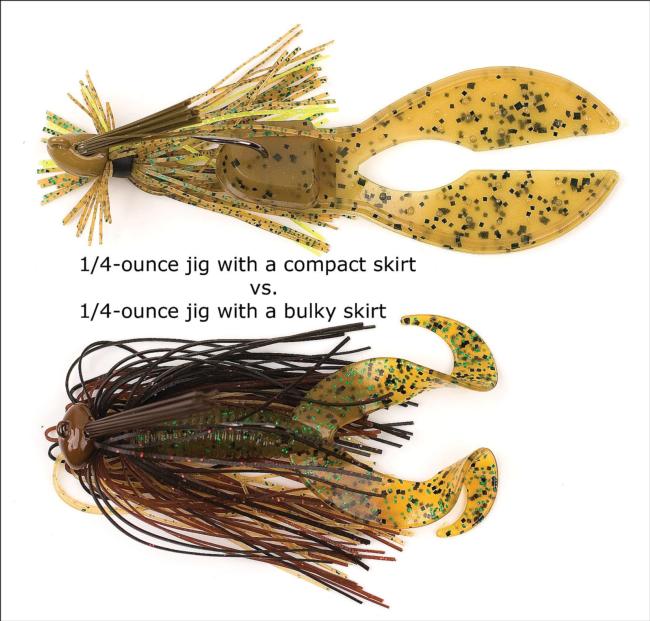
“They put on a big craw feed in the fall,” Hibdon said. “I’m a big crawdad fan and not just because of the (Luck “E” Strike) Guido Bug. The Ozarks are crawdad infested.”
Contrary to the common perception that craws are fast-scooting motion machines, Hibdon’s hours of observations have convinced him there are certain conditions when they don’t move around all that much. Fall is one of those times. So that is when he will downsize his jig and let the craw-imitator slowly descend through the bass’ line of sight.
Precision plastics
While a jig can be a deadly slow-falling presentation, there is nothing more tempting than a slow-sinking soft-plastic lure.
“The trend in the sport in recent years has been to go to lighter weights,” Yelas said. “With all of the fishing pressure on most of our public lakes, you want the most natural, lifelike action you can get. Most of these bass have been caught at least once, so they’re not going to be fooled easily.”
No single lure has demonstrated the effectiveness of lightly weighted, slow-falling soft plastics better than the Yamamoto Senko. Inventor and FLW Tour pro Gary Yamamoto of Palestine, Texas, won’t disclose the formula that makes it descend at such a tantalizingly slow rate, but it is deadly in the spring.
“I’ll make long casts with it during the prespawn and spawn,” Yamamoto said. “The back-and-forth descent, with the tips waggling, brings in roaming bass from long distances.”
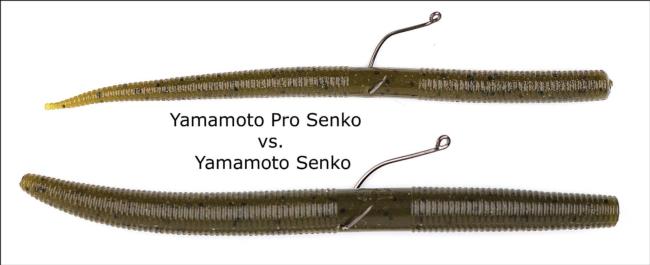
As effective as it is, there are some circumstances when even the Senko and its ilk are too bulky and animated.
“I’ve seen situations where the only lure the bass would eat was a little finesse worm,” Yelas said.
It is a situation that often occurs with Florida-strain bass after a cold front. Like Hibdon’s admonition that sometimes less action is more in a jig trailer, sometimes the heavy vibration of a lure with too many appendages or too much action is a turnoff. That is when a lightly weighted finesse worm, with no negative cues, can be deadly.
Yelas extended this line of thinking to Carolina rigging in clear water. When the fish are finicky and a soft-plastic worm is the lure of choice, a 1/8-ounce split shot can produce more action than a 1/2-ounce or greater Carolina-rig weight. The lighter weight forces an angler to slow down. Plus, when the weight is pulled forward or off the bottom, the more gradual fall will tempt fish that are otherwise put off by the bottom-plundering trail of a large lure trailing a heavy weight.
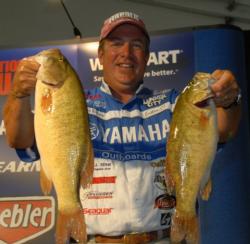
Is slow-fall fishing the most fun fishing on the lake? Probably not. But when conditions get tough or the fish aren’t fully committing to an offering, slowing down can put fish in the boat. And that is fun.
Postspawn smallies
FLW Tour pro Terry Baksay of Easton, Conn., has developed a slow-falling, postspawn jig technique that can be deadly anywhere there is vegetation. It is especially effective for Northern smallmouths – he has used it effectively on Lake Champlain, 1000 Islands and particularly on Candlewood Lake, his home lake.
“I take a white jig and swim it pretty fast across the top of the grass,” he said. “When I get to the edge, I let it fall.”
The jig in question is a homemade model, either 1/8 or 1/16 ounce, depending on wind, current and how much water there is above the greenery. Any heavier and the jig will fall too fast to trigger strikes. Baksay tips the lightweight jig with a matching Lunker City HydroTail Grub, which not only provides tantalizing action on the fall, but also enough heft to cast it on baitcasting tackle.
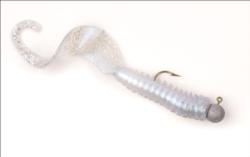 Once the immediate postspawn is over, the bite tends to die off as the fish retreat into their summer depths. But for that brief window of time it will produce arm-breaking strikes.
Once the immediate postspawn is over, the bite tends to die off as the fish retreat into their summer depths. But for that brief window of time it will produce arm-breaking strikes.
A different line of thinking
Another way to vary the sink rate of lures is through an adjustment of line size or type. Anglers on Lake Okeechobee have done this for years with lipless crankbaits to fish them over shallow grass. A 1/4-ounce lipless crankbait burned over the grass on 14-pound monofilament may dig in and get snagged too often to be effective. If it is tied to 25-pound mono, the crank will stay up in the water column enough to come back clean more often than not.
While Chevy pro Dion Hibdon is hesitant to monkey around with his line weights, fellow Chevy pro Jay Yelas does tinker for the purpose of adjusting fall rates.
“Sometimes with a big, bulky jig I’ll go to 25- or 30-pound line,” Yelas said. “It really slows down the lure. I’ll do that occasionally with jigs, but never with soft plastics.”
